
The Lincoln, sometimes called the Lincoln Longwool, is a breed of sheep from England. The Lincoln is the largest British sheep, developed specifically to produce the heaviest, longest and most lustrous fleece of any breed in the world. Great numbers were exported to many countries to improve the size and wool quality of their native breeds. The versatile fleece is in great demand for spinning, weaving and many other crafts.

The Soay sheep is a breed of domestic sheep descended from a population of feral sheep on the 100-hectare (250-acre) island of Soay in the St Kilda Archipelago, about 65 kilometres (40 mi) from the Western Isles of Scotland. It is one of the Northern European short-tailed sheep breeds.
The Hebridean is a breed of small black sheep from Scotland, similar to other members of the Northern European short-tailed sheep group, having a short, triangular tail. They often have two pairs of horns. They were often formerly known as "St Kilda" sheep, although unlike Soay and Boreray sheep they are probably not in fact from the St Kilda archipelago.

Not to be confused with the Olde English 'Babydoll' Southdown sheep.
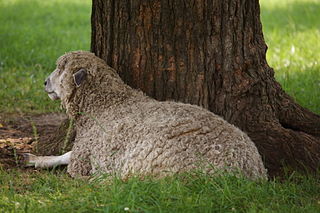
The Leicester Longwool is an English breed of sheep. Alternative names for the breed include: Leicester, Bakewell Leicester, Dishley Leicester, English Leicester, Improved Leicester and New Leicester. It was originally developed by 18th-century breeding innovator Robert Bakewell.
The Whiteface Dartmoor is a breed of domestic sheep originating in the Dartmoor region of south west England. The Rare Breeds Survival Trust has designated this breed as "at risk".
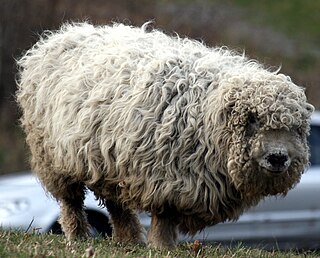
The Greyface Dartmoor is a rare breed of domestic sheep originating around Dartmoor in south west England. Also known as the "Improved Dartmoor", this is a large and long-woolled breed, known for its distinctive facial markings. Its fleece can weigh 7 to 9 kg, and today the breed is primarily raised for meat.

The Dorset Horn is an endangered British breed of domestic sheep. It is documented from the seventeenth century, and is highly prolific, sometimes producing two lambing seasons per year. Among British sheep, it is the only breed capable of breeding throughout the winter.

The Shetland is a small, wool-producing breed of sheep originating in the Shetland Isles, Scotland but is now also kept in many other parts of the world. It is part of the Northern European short-tailed sheep group, and it is closely related to the extinct Scottish Dunface. Shetlands are classified as a landrace or "unimproved" breed. This breed is kept for its very fine wool, for meat, and for conservation grazing.

The Norfolk Horn is one of the British black-faced sheep breeds. It differs from other black-faced breeds, which are mainly found in high-rainfall, upland areas, and from most other modern, lowland British sheep breeds in being lightly built and very hardy. This breed is raised primarily for meat.

The Portland is a sheep breed that takes its name from the Isle of Portland in Dorset, England. This breed is raised primarily for meat.
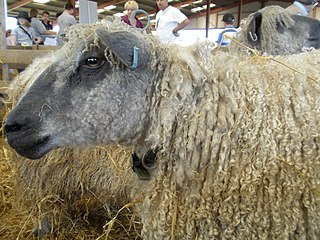
The Wensleydale is a British breed of domestic sheep. It is named for the Wensleydale region of North Yorkshire, in the north of England, where it was bred in the early nineteenth century by cross-breeding a Dishley Leicester ram with local long-woolled sheep of a breed that is now extinct. It has a blue-grey face and long purled wool, and is among the heaviest of British sheep breeds. It is an endangered breed, and is categorised as "at risk" by the Rare Breeds Survival Trust. It is often used as a ram breed to cross with other breeds to obtain market lambs, and for its high-quality wool.
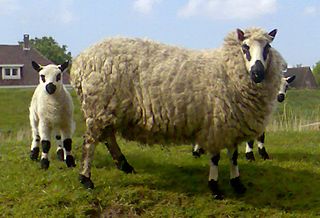
The Kerry Hill is a breed of domestic sheep originating in the county of Powys in Wales. It derives its name from the village of Kerry (Ceri), near Newtown. Kerry Hill sheep have a distinctive and unique coloration, with a white face bearing black markings around the mouth, ears, and eyes. Both rams and ewes are polled. Their wool is white, and their legs are white with black markings. First mentions of the breed date back to the early 19th century, and today it is distributed throughout the United Kingdom, Ireland, the Netherlands, Germany and Denmark. Though still not very numerous, the breed was removed from the records of the Rare Breeds Survival Trust watchlist in 2006. This breed is primarily raised for meat.
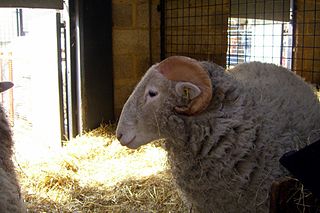
The Whitefaced Woodland is a sheep breed from the Woodlands of Hope an area in the South Pennines in England. It is a combination of two breeds, the Woodland and the Penistone sheep after the Yorkshire town where sheep sales have been held since 1699. It is thought to be closely related to the Swaledale and the Lonk. Substantial commercial flocks of the Whitefaced Woodland are kept in its region of origin, but it is listed as a vulnerable breed by the Rare Breeds Survival Trust, since there are fewer than 900 registered breeding females in Great Britain.

The Teeswater is a breed of sheep from Teesdale, England. It is a longwool breed of sheep, which produces a generally large-diameter fibre. The breed is raised primarily for meat.

The Boreray, also known as the Boreray Blackface or Hebridean Blackface, is a breed of sheep originating on the St Kilda archipelago off the west coast of Scotland and surviving as a feral animal on one of the islands, Boreray. The breed was once reared for meat and wool, but is now used mainly for conservation grazing. The Boreray is one of the Northern European short-tailed sheep group of breeds.
The Llanwenog is a breed of domestic sheep originating in Wales. It was developed in the 19th century from the Llanllwni, the Shropshire, Welsh Mountain, and Clun Forest breeds. The Llanwenog's native locale is the Teifi Valley, in western Wales, but it has since spread into other areas. The breed association was formed in 1957. Llanwenogs have black faces and medium-length wool. They have a docile temperament and are known for their profligacy in lambing. The breed has a very placid temperament, is easily handled, easily contained and is well suited to stress free inwintering if necessary. This has important consequences for the health of both the animal and its keeper. This breed is raised primarily for meat.
The Hill Radnor is a breed of domestic sheep originating in the United Kingdom. Classified as one of the mountain breeds, it is most common from Powys down to southwest Herefordshire and Monmouthshire. The Hill Radnor has a dense white fleece, with a light brown face and legs. Ewes are polled and rams are horned. It is hardy and forages well, like many hill breeds. Hill Radnor ewes have good maternal instincts, and are sometimes crossed with lowland rams to yield market lambs or mules. Lambing percentages vary under different conditions but the breed can easily average around 155%. The breed is listed as "vulnerable" by the Rare Breeds Survival Trust of the U.K.
The Watch list of the Rare Breeds Survival Trust is a listing of rare and native United Kingdom breeds of domestic cattle, sheep, pigs, horses, goats and poultry, compiled by the Rare Breeds Survival Trust.














